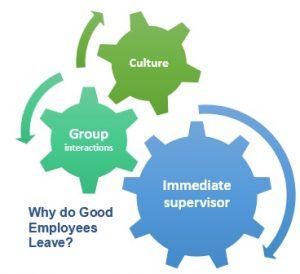Why do Good Employees Leave? Arcus asked 185 senior HR executives this question last month. The findings were surprising.
It appears the top reason why good employees leave is their immediate supervisor. This individual has the single biggest impact on the professional growth, performance and job satisfaction of staff members. It appears most organizations conduct employee satisfaction surveys but very few actually take a deep dive into the top 5 drivers of satisfaction to understand the dynamics at play at a micro level. Our research indicates that the primary focus of satisfaction surveys needs to be on group interactions that take place on a daily basis between employees above, below and at the same level within organisations.
Drivers of satisfaction and dissatisfaction
Understanding these interactions will provide clues on the drivers of satisfaction and dissatisfaction across a range of 25 triggers that Arcus has identified and measured in over 20 employee satisfaction surveys. This benchmarking process provides invaluable insights into how these group dynamics are working vs. other peer organizations of the same size and scale. For example, the group dynamics are simpler in smaller organizations. However, once you get to 150+ employees, there tends to be a significant increase in the complexity of work flow and silos within these organisations. Often, decision making processes are undermined by limited or strategic information sharing. As a result, the level of transparency and velocity around decisions gets eroded rapidly, especially when contentious issues that impact budgets, resources and processes come into play.

How do you keep good employees?
Satisfaction surveys offer a data deluge without specific performance outcome oriented metrics. Start with a decision flow eco-system. The first step is to understand how employees interact across the eco-system. This may involve an in-depth look at how decisions are made and how information flows within an organization. Sounds complex and esoteric? It isn’t. The process followed by Arcus includes a series of confidential in-depth interviews with managers and staff to get answers to two simple open-ended questions: what is working well and what can be done better.
The feedback is transcribed and run through a proprietary algorithm that identifies frequently mentioned phrases and provides cues on satisfaction levels across a range of decision velocity influencers. For example, are certain types of bottle necks, such as budget approvals, frequently referenced across business units, functional areas or levels? The action oriented process provides a specific set of recommendations to address each variable that is inhibiting group and individual staff performance.
Once the decision flow eco-system has been developed by Arcus, the data will be layered and benchmarked with a comparable set of best-in-class organisations to see if information and decision flow levels are consistent with the way it works in your organization vs. others. If not, we will look for bottle necks where these variables break down.
Arcus has found that out of the 25 drivers analysed, a key driver is job security. Do employees feel they are valued and are they concerned about their future at the organization? A weighted satisfaction impact assessment of these 25 drivers benchmarked against the best in class standard will provide insights into the top areas where these issues need to be addressed and the managers who may be impacting staff satisfaction the most.
Service coverage
The variety, breadth, and depth of the projects where Arcus can be a resource are made unique by each client’s specific needs. By providing a very small sample of projects we’ve completed, we can help you understand how and when to use our services. Visit the links below to find out more about a specific problem or opportunity you would like to address.
“Arcus manages to consistently deliver tangible results on market research and strategy projects. They combine deep business expertise, powerful research capabilities, and innovative thinking to deliver substantial value.”
– Vice President, Nikon
Human Resources – Insights and Ideas
Human Resources – Insights and Ideas to help people managers optimize their strategies, strengthen retention and motivate staff. Read more.

Featured research: Beyond KPIs. The Importance of Building Trust. We haven’t seen a 12-point dip in the Arcus Index (that includes 55 dimensions of trust) since the Enron days. The latest results of the Arcus Trust Index survey indicate that trust in business in Canada has declined precipitously by 12 points to 42% over the past year. People simply don’t trust others like they used to. Many leaders can attest to this experience: You ask your team to carry out a task that has enough flexibility for creative input. Rather than making their own decisions, the team comes to you with an onslaught of questions, trying to pin down the exact parameters of the task. Read more.
